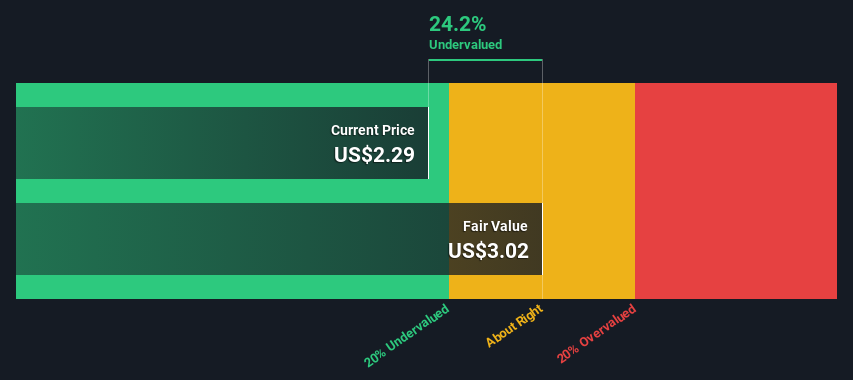- United States
- /
- Biotech
- /
- NasdaqGM:BNR
Burning Rock Biotech Limited (NASDAQ:BNR) Shares Could Be 24% Below Their Intrinsic Value Estimate

Key Insights
- The projected fair value for Burning Rock Biotech is US$3.02 based on 2 Stage Free Cash Flow to Equity
- Burning Rock Biotech is estimated to be 24% undervalued based on current share price of US$2.29
- Industry average discount to fair value of 38% suggests Burning Rock Biotech's peers are currently trading at a higher discount
Does the July share price for Burning Rock Biotech Limited (NASDAQ:BNR) reflect what it's really worth? Today, we will estimate the stock's intrinsic value by taking the expected future cash flows and discounting them to their present value. One way to achieve this is by employing the Discounted Cash Flow (DCF) model. There's really not all that much to it, even though it might appear quite complex.
We generally believe that a company's value is the present value of all of the cash it will generate in the future. However, a DCF is just one valuation metric among many, and it is not without flaws. Anyone interested in learning a bit more about intrinsic value should have a read of the Simply Wall St analysis model.
Check out our latest analysis for Burning Rock Biotech
The Method
We're using the 2-stage growth model, which simply means we take in account two stages of company's growth. In the initial period the company may have a higher growth rate and the second stage is usually assumed to have a stable growth rate. To begin with, we have to get estimates of the next ten years of cash flows. Where possible we use analyst estimates, but when these aren't available we extrapolate the previous free cash flow (FCF) from the last estimate or reported value. We assume companies with shrinking free cash flow will slow their rate of shrinkage, and that companies with growing free cash flow will see their growth rate slow, over this period. We do this to reflect that growth tends to slow more in the early years than it does in later years.
A DCF is all about the idea that a dollar in the future is less valuable than a dollar today, so we need to discount the sum of these future cash flows to arrive at a present value estimate:
10-year free cash flow (FCF) estimate
| 2024 | 2025 | 2026 | 2027 | 2028 | 2029 | 2030 | 2031 | 2032 | 2033 | |
| Levered FCF (CN¥, Millions) | -CN¥318.0m | -CN¥133.0m | -CN¥17.0m | CN¥46.0m | CN¥76.6m | CN¥112.7m | CN¥150.6m | CN¥187.1m | CN¥219.9m | CN¥248.4m |
| Growth Rate Estimate Source | Analyst x1 | Analyst x1 | Analyst x1 | Analyst x1 | Est @ 66.48% | Est @ 47.17% | Est @ 33.65% | Est @ 24.19% | Est @ 17.57% | Est @ 12.93% |
| Present Value (CN¥, Millions) Discounted @ 7.8% | -CN¥295 | -CN¥114 | -CN¥13.6 | CN¥34.0 | CN¥52.5 | CN¥71.7 | CN¥88.8 | CN¥102 | CN¥112 | CN¥117 |
("Est" = FCF growth rate estimated by Simply Wall St)
Present Value of 10-year Cash Flow (PVCF) = CN¥155m
We now need to calculate the Terminal Value, which accounts for all the future cash flows after this ten year period. For a number of reasons a very conservative growth rate is used that cannot exceed that of a country's GDP growth. In this case we have used the 5-year average of the 10-year government bond yield (2.1%) to estimate future growth. In the same way as with the 10-year 'growth' period, we discount future cash flows to today's value, using a cost of equity of 7.8%.
Terminal Value (TV)= FCF2033 × (1 + g) ÷ (r – g) = CN¥248m× (1 + 2.1%) ÷ (7.8%– 2.1%) = CN¥4.4b
Present Value of Terminal Value (PVTV)= TV / (1 + r)10= CN¥4.4b÷ ( 1 + 7.8%)10= CN¥2.1b
The total value, or equity value, is then the sum of the present value of the future cash flows, which in this case is CN¥2.2b. In the final step we divide the equity value by the number of shares outstanding. Relative to the current share price of US$2.3, the company appears a touch undervalued at a 24% discount to where the stock price trades currently. The assumptions in any calculation have a big impact on the valuation, so it is better to view this as a rough estimate, not precise down to the last cent.

Important Assumptions
The calculation above is very dependent on two assumptions. The first is the discount rate and the other is the cash flows. Part of investing is coming up with your own evaluation of a company's future performance, so try the calculation yourself and check your own assumptions. The DCF also does not consider the possible cyclicality of an industry, or a company's future capital requirements, so it does not give a full picture of a company's potential performance. Given that we are looking at Burning Rock Biotech as potential shareholders, the cost of equity is used as the discount rate, rather than the cost of capital (or weighted average cost of capital, WACC) which accounts for debt. In this calculation we've used 7.8%, which is based on a levered beta of 0.800. Beta is a measure of a stock's volatility, compared to the market as a whole. We get our beta from the industry average beta of globally comparable companies, with an imposed limit between 0.8 and 2.0, which is a reasonable range for a stable business.
SWOT Analysis for Burning Rock Biotech
- Currently debt free.
- No major weaknesses identified for BNR.
- Forecast to reduce losses next year.
- Good value based on P/S ratio and estimated fair value.
- Has less than 3 years of cash runway based on current free cash flow.
Next Steps:
Valuation is only one side of the coin in terms of building your investment thesis, and it is only one of many factors that you need to assess for a company. The DCF model is not a perfect stock valuation tool. Preferably you'd apply different cases and assumptions and see how they would impact the company's valuation. For instance, if the terminal value growth rate is adjusted slightly, it can dramatically alter the overall result. Why is the intrinsic value higher than the current share price? For Burning Rock Biotech, we've put together three important items you should explore:
- Risks: Be aware that Burning Rock Biotech is showing 1 warning sign in our investment analysis , you should know about...
- Future Earnings: How does BNR's growth rate compare to its peers and the wider market? Dig deeper into the analyst consensus number for the upcoming years by interacting with our free analyst growth expectation chart.
- Other High Quality Alternatives: Do you like a good all-rounder? Explore our interactive list of high quality stocks to get an idea of what else is out there you may be missing!
PS. The Simply Wall St app conducts a discounted cash flow valuation for every stock on the NASDAQGM every day. If you want to find the calculation for other stocks just search here.
Valuation is complex, but we're here to simplify it.
Discover if Burning Rock Biotech might be undervalued or overvalued with our detailed analysis, featuring fair value estimates, potential risks, dividends, insider trades, and its financial condition.
Access Free AnalysisHave feedback on this article? Concerned about the content? Get in touch with us directly. Alternatively, email editorial-team (at) simplywallst.com.
This article by Simply Wall St is general in nature. We provide commentary based on historical data and analyst forecasts only using an unbiased methodology and our articles are not intended to be financial advice. It does not constitute a recommendation to buy or sell any stock, and does not take account of your objectives, or your financial situation. We aim to bring you long-term focused analysis driven by fundamental data. Note that our analysis may not factor in the latest price-sensitive company announcements or qualitative material. Simply Wall St has no position in any stocks mentioned.
About NasdaqGM:BNR
Burning Rock Biotech
Develops and sells cancer therapy selection tests in the People's Republic of China and the United States.
Flawless balance sheet and slightly overvalued.
Similar Companies
Market Insights
Community Narratives




